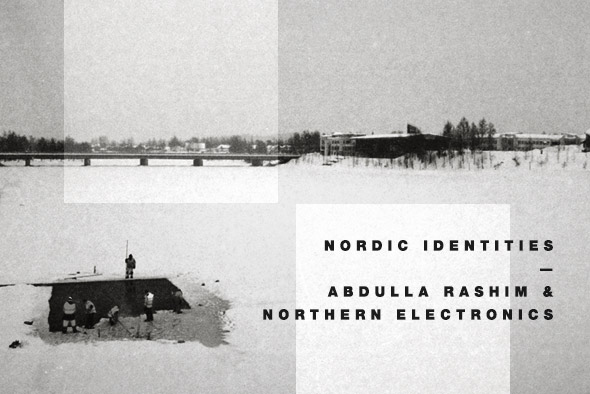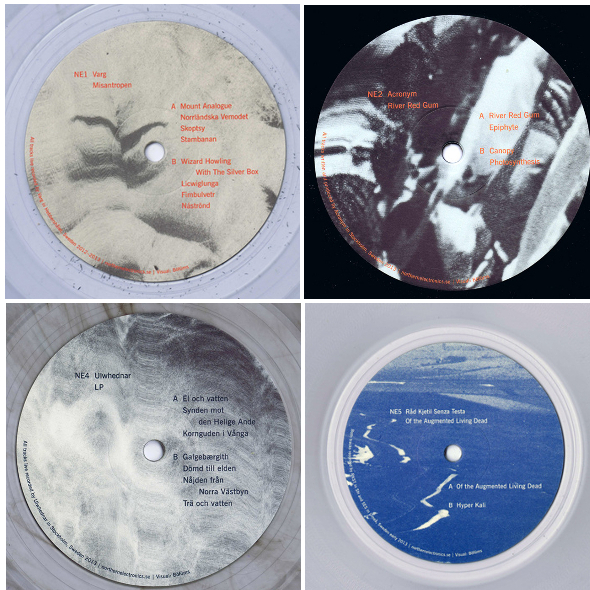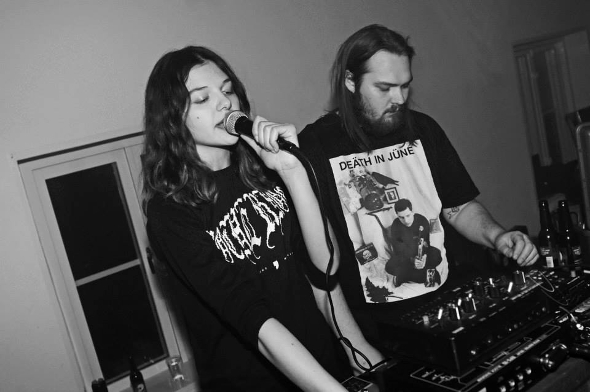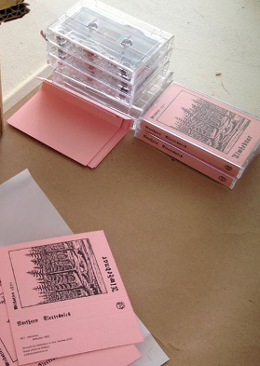Nordic Identities: Abdulla Rashim & Northern Electronics

Matthew Kent dials up Abdulla Rashim to discuss the Swedish producer’s music, the growing relationship between the labels he’s involved with and his approach to identity.
“These fields of music I’m working with tends to be the ones that is the most comfortable to listen to. I don’t disagree that the term ‘hypnotic’ might fit what I’m doing, but only if the recipient is willing to dive into it.”
As the above statement from the artist himself attests, Abdulla Rashim’s work is hard to sum up in a sentence, or paragraph, without falling back on words like ‘repetitive’ and ‘hypnotic’ – or without reference to a handful of established artists mining such comparable seams of techno. Just as it’s hard to contextually grapple with how works of visual minimalism make so much of so little, this music works to an extent to deflect and evade description. Pragmatism is easy; each record a shrine to drone, techno, the art of the loop. Minimalism as generator. But to begin to speculate on what is projected… It’s more often a case of what the listener brings to the table as much any specific aim of the creator. Ten minutes of something like the below track “Asayita” can feel far too short or an eternity entirely based on one’s mood, and the contents can drift and reform depending on whatever element is being focused in on at the time. It’s often a struggle to define whether the sound is being manipulated to evolve by the author’s hand, or if the gradual inertia brought on such tightly focused loops produces its own internal state of projected mutation. These are all base elements that make techno such a fascinating infrastructure, but Abdulla Rashim really nails it with rare tenacity.
Talking to Rashim, it’s clear that he also either similarly struggles to characterise the work through traditional dialogue, or rejects the notion wholeheartedly. In correspondence, he vaguely outlines his methodology as a process through which multitudes of interpretation can be discovered. “I want to continue exploring, sounds will always just be sounds no matter what you label you put on it. I have an idea of a mood when I write something, I want to make music that evokes emotion, but I can never know how others will perceive it. That’s exciting.”
“I completely understand the need to break down something and put it to words. But I never have any specific intentions with what I’m doing, I just do it. I’m happy if it can be embraced in more than one way.” His continued cloak of anonymity certainly helps to propel the idea, with not much publicly ‘out’ other than his Swedish nationality. And though within the world of techno there’s a fair bit of baggage to the attitude of ‘anon’ (often suggestive of that particular techno trope for producers to circumvent the lagging belief in their existing identity, or to engineer hype and sell off average white-label dub techno), in Rashim’s case it seems to speak of a hesitation to publicly attach personal or private identity to a piece of art.
“I use a moniker because I don’t feel comfortable with having me as a person exploited on the internet; I’m no exhibitionist, rather the opposite. The intention has never been to remain anonymous for all time, but simply to reduce the harm as much as possible and slow down the process. Naturally my identity is to be revealed more and more by my appearances. But to have it happen that way is fair, it’s natural. I can’t do anything about it.”
 In the rise of an all-personal-information-everywhere digital age it’s a reasonable stance to take, and comes with the added benefit of allowing the work to exist unencumbered by peripheral information. Indeed that space where an identity might otherwise sit has allowed Rashim to slowly, quietly introduce slim concepts that hint at something within the music. Repeated African and Arab motifs, particularly in reference to Ethiopia, speckle his work and sharpen the edges. He confirms that connection, suggesting a coincidental crossing of paths within his life as he became more interested in the culture that led to him “exploring that more”. Perhaps future releases will continue to further allow a link between his sonic framework and a more conceptual or moral outlook. Certainly the fact that the majority of his releases come via his own self-run label means there’s plenty of space for supervising and cultivating a sense of identity.
In the rise of an all-personal-information-everywhere digital age it’s a reasonable stance to take, and comes with the added benefit of allowing the work to exist unencumbered by peripheral information. Indeed that space where an identity might otherwise sit has allowed Rashim to slowly, quietly introduce slim concepts that hint at something within the music. Repeated African and Arab motifs, particularly in reference to Ethiopia, speckle his work and sharpen the edges. He confirms that connection, suggesting a coincidental crossing of paths within his life as he became more interested in the culture that led to him “exploring that more”. Perhaps future releases will continue to further allow a link between his sonic framework and a more conceptual or moral outlook. Certainly the fact that the majority of his releases come via his own self-run label means there’s plenty of space for supervising and cultivating a sense of identity.
Interestingly though, the greatest glimpse behind that curtain has come about through the propagation of others’ work, with the foundation last year of new label Northern Electronics. In contrast to Abdullah Rashim Records and its status as a one-man project, Rashim has served to highlight a handful of new Swedish artists that work under a variety of tones and textures, with more explicit drone and noise based works sitting alongside the kind of techno analogous to Rashim. It’s an aesthetically distinct enterprise, with far more focus falling on Scandinavian heritage and working out how to slot that into a variety of auditory spaces.
“The idea of Abdulla Rashim Records has always just been to be able to publish records of my own in a simple way without messing around too much, like a straight pipeline from the studio to the stores. No PR agency or release schedule and no bullshit. In the beginning I had the idea that I might want to put out music from friends or so but as more as I tried to imagine sounds that would be fitting the more I came to understand that the idea I’m having of what A.R.R. should sound like is so narrow. I realised that nothing else besides my own work would ever make it there, that’s why I started Northern Electronics.”
“I wanted to be able to work more with friends in different ways, like working with great graphic designers Böfüms, and being able to do different music projects together with friends, just having an output for everything that is happening around me. Identity is very important, everything I do is derived from conceptual ideas and a stream of discussions with the people around me, that’s where I get the energy to do this from.”
 Releases from Acronym and Varg (pictured above performing with Sars) have plunged into creating similarly heady techno atmospheres, striking a meeting point between repeating structure and enveloping ambience or noise. The latter’s work is particularly striking for forging potentially untapped links between techno and black metal. His one release for Northern Electronics so far files down the explicit pairing considerably (an earlier cassette for label Peferin made the rather more decisive and divisive statement to include ‘the ashes of a burnt down church’ with every copy) to produce blueprint Misantropen; a smoky, melancholy affair engulfed in reverb, in which the acid line is recast over and over as chronic dirge. Both artists work under varying veils of anonymity as Rashim does, and the general impression is that a lot of their recent work has channeled to become a concurrent flow of criss-crossing ideas and experiments.
Releases from Acronym and Varg (pictured above performing with Sars) have plunged into creating similarly heady techno atmospheres, striking a meeting point between repeating structure and enveloping ambience or noise. The latter’s work is particularly striking for forging potentially untapped links between techno and black metal. His one release for Northern Electronics so far files down the explicit pairing considerably (an earlier cassette for label Peferin made the rather more decisive and divisive statement to include ‘the ashes of a burnt down church’ with every copy) to produce blueprint Misantropen; a smoky, melancholy affair engulfed in reverb, in which the acid line is recast over and over as chronic dirge. Both artists work under varying veils of anonymity as Rashim does, and the general impression is that a lot of their recent work has channeled to become a concurrent flow of criss-crossing ideas and experiments.
“I met both Varg and Acronym through another hobby which we had a common interest for, it wasn’t music that brought us together in the first place but it has definitely made us better friends. I think we share the same idea about publicity and “anonymity”, none of us are interested in standing in the spotlight. It’s totally uninteresting and repulsive. They are both just regular music nerds like me.”
One of these collaborative projects Ulwhednar (between Varg and Rashim) has swung between techno and a much looser exploration of noise. The weightier techno has been pressed to wax, as on the mini-album LP, and the ambient works have mostly been duplicated onto the spools of a cassette, as with Withatten 1892 and Midvinter. Both choices fit the content naturally. “Putting out tapes is nice because you get a physical product to work with but it’s not as big an engagement as going through the procedure of pressing a record.” says Rashim. “How I decide what goes to what format is just a feeling, like – does this music NEED to get on wax or is tape enough? I like listening to tapes because you’re forced to commit to it all the way; it’s not as easy to skip through parts you may not like. That’s how it’s intended to be.”
Despite the divisional differences in format there’s no real sense of dichotomy in the two accents. It’s one of the more exciting and telling aspects of Northern Electronics that a threshold between functionality and atmospheric narrative is being honed in on more closely over time. All within single, collaborative and split projects. The freshly released Of the Augmented Living Dead from Råd Kjetil Senza Testa combines residual techno components with an almost Berlin School-inspired ambience, as dub techno chords are painted under and over dormant arpeggios. Coupled with the long-form  nature of the record (a hallmark of the record’s origin as cassette on the Swedish Zeon Light label, playing out at just under 25 minutes a side) there’s an apparent consolidation of the two separate identities that Ulwhednar has toyed with. Clearly it’s an ongoing dialogue assembled from several artists, all inhabiting a similar psychogeography.
nature of the record (a hallmark of the record’s origin as cassette on the Swedish Zeon Light label, playing out at just under 25 minutes a side) there’s an apparent consolidation of the two separate identities that Ulwhednar has toyed with. Clearly it’s an ongoing dialogue assembled from several artists, all inhabiting a similar psychogeography.
“We’re inspired by the nature surrounding us and the somewhat forgotten histories that can be found here. This just seems appropriate to translate in to the music. It feels like something we can connect with in an honest way as we’ve grown up with it. The aesthetics and references are things that shaped us. While other electronic music producers might have their visions coming in science and space that’s just not something we’re in to.” This communal aspect of the label has already also spilled over into a live setting, with the first label night at Under Bron in Stockholm late last year. “We just did one big show so far, but a few more are planned this year. I want to push the music we’re doing and the fact that most of us are playing live sets so that’s where the focus lies.”
“Northern Electronics is also about having fun, to integrate people I like in the passage – like having my friend Axel Hallqvist play at one of our label nights; even though he haven’t released anything on the label yet he’s deeply connected.”
So what’s next for the label, and how does the ongoing Abdulla Rashim Records output align with Northern Electronics? All signs seem to point towards an integration that allows each avenue to nourish the other. “I will keep on trying to do stuff that excites me and we’ll see where it takes the music. I am actually preparing my first Abdulla Rashim release on Northern Electronics; it will be an album coming sometime this year. I didn’t intend to do any Rashim material on Northern Electronics at first but as soon as I started planning this record I just followed my guts which are always leading the way, and it suddenly made sense to do it. As I said I always saw A.R.R. as a platform for putting out singles in a smooth way without all the nonsense around it, but for this album I wanted to work in a slightly different way.”
“Next up there’s Korridor’s first record which has been way overdue, I actually wanted him to be the first one out last year but then life happened. A new Ulwhednar LP is finished and has been for a while, and Acronym did another killer record. And then have two tapes coming somewhere between all of this, one from Swedish goth-industrial DIY artist Vit Fana and another one from newcomer, SARS. The future’s looking really exciting and I’m happy to keep on establishing something with all of these great people.”
Interview by Matthew Kent